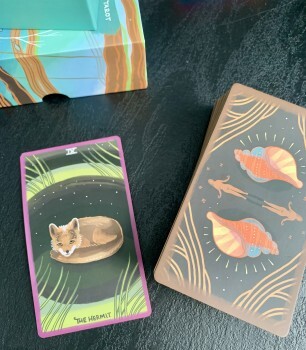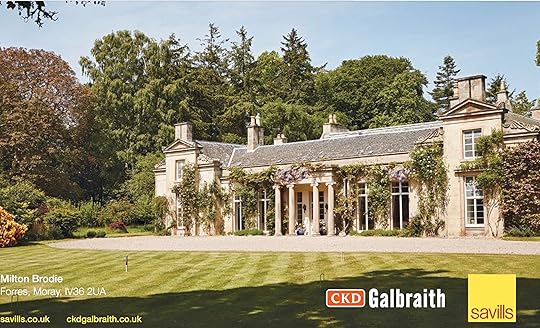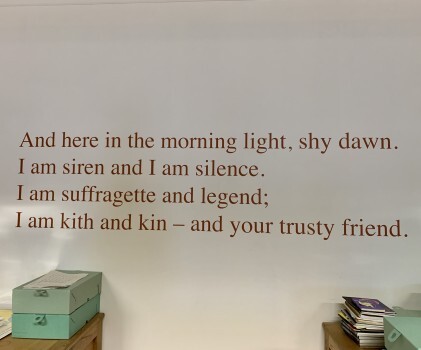Week One
 I promised myself I wouldn’t measure my productivity while I’m away. Yesterday I pulled the hermit card and I’m pushing back on the guilt I often feel when I’m traveling—“Don’t stay in! Make the most of the time you have! Do something worth photographing so you can share it on Instagram!” But if I really do want an ordinary life, then I need to be who I am, which is an introvert and homebody. I watched a ten-part Australian drama yesterday, taking two short breaks to venture out into the world. I’m still wearing my pedometer and counting my daily 10K steps, but I have no scale to weigh myself on and just set my jeans aside when they felt too snug. The goal is to write a poem a day; so far they’re mostly haikus, which still counts as far as I’m concerned. Haikus are like kernels, nuggets of truth and small observations that can be mined more fully later on. I went back to Pollok House on Tuesday and wrote in the cafe for a while before heading to the garden; a park employee helped me track down the carpenter Neil who built the ship in the garden (the working title of my novel). It wasn’t his idea but he designed and built it; the unusual planter is meant to acknowledge the Maxwells’ involvement in trans-Atlantic trade. I didn’t tell him that it made me think of a slave ship. If people are open and willing to share their knowledge with me, then I give the bare minimum in exchange: I’m doing research for a book for young readers. I realized last night that if I want to include more graphic content about the experiences of the enslaved, I’ll have to age my characters up; that likely means changing the format of the novel. This morning on BBC Scotland the radio host interviewed someone about reluctant readers and how many teenage boys see reading as a form of punishment. The two books I’ve seen on slavery and Scotland are both graphic novels—a good strategy to reach kids who might otherwise be uninterested in the topic. I wonder if a verse novel might appeal to teens more than traditional prose—or a play (for stage or radio). I met a couple of men on my last two trips to Scotland; they both focus on Scotland’s buried history and both have been really generous with their resources. Through Nelson (whose mother is from St. Kitt’s) I’ve lined up a school visit here in Glasgow, and Stephen has kindly offered to share his source documents on Frederick. I’m thankful for you readers, too, who reached out with suggestions and offers of help. After last week’s blog post, my cousin Beverley in Toronto let me know that there is a former plantation in Nevis called Colhouns—a little digging online revealed that it was owned by Fanny’s brother. It was her dowry and inheritance that added to Sir James Maxwell’s wealth and the Scottish National Trust’s report suggests that money was used to improve Pollok House and the surrounding grounds. I’ve found conflicting accounts—were they married in St. Kitts or in Glasgow? Was she living there or here when they met?—but those details aren’t essential to my projects. Yet. Working on three books
I promised myself I wouldn’t measure my productivity while I’m away. Yesterday I pulled the hermit card and I’m pushing back on the guilt I often feel when I’m traveling—“Don’t stay in! Make the most of the time you have! Do something worth photographing so you can share it on Instagram!” But if I really do want an ordinary life, then I need to be who I am, which is an introvert and homebody. I watched a ten-part Australian drama yesterday, taking two short breaks to venture out into the world. I’m still wearing my pedometer and counting my daily 10K steps, but I have no scale to weigh myself on and just set my jeans aside when they felt too snug. The goal is to write a poem a day; so far they’re mostly haikus, which still counts as far as I’m concerned. Haikus are like kernels, nuggets of truth and small observations that can be mined more fully later on. I went back to Pollok House on Tuesday and wrote in the cafe for a while before heading to the garden; a park employee helped me track down the carpenter Neil who built the ship in the garden (the working title of my novel). It wasn’t his idea but he designed and built it; the unusual planter is meant to acknowledge the Maxwells’ involvement in trans-Atlantic trade. I didn’t tell him that it made me think of a slave ship. If people are open and willing to share their knowledge with me, then I give the bare minimum in exchange: I’m doing research for a book for young readers. I realized last night that if I want to include more graphic content about the experiences of the enslaved, I’ll have to age my characters up; that likely means changing the format of the novel. This morning on BBC Scotland the radio host interviewed someone about reluctant readers and how many teenage boys see reading as a form of punishment. The two books I’ve seen on slavery and Scotland are both graphic novels—a good strategy to reach kids who might otherwise be uninterested in the topic. I wonder if a verse novel might appeal to teens more than traditional prose—or a play (for stage or radio). I met a couple of men on my last two trips to Scotland; they both focus on Scotland’s buried history and both have been really generous with their resources. Through Nelson (whose mother is from St. Kitt’s) I’ve lined up a school visit here in Glasgow, and Stephen has kindly offered to share his source documents on Frederick. I’m thankful for you readers, too, who reached out with suggestions and offers of help. After last week’s blog post, my cousin Beverley in Toronto let me know that there is a former plantation in Nevis called Colhouns—a little digging online revealed that it was owned by Fanny’s brother. It was her dowry and inheritance that added to Sir James Maxwell’s wealth and the Scottish National Trust’s report suggests that money was used to improve Pollok House and the surrounding grounds. I’ve found conflicting accounts—were they married in St. Kitts or in Glasgow? Was she living there or here when they met?—but those details aren’t essential to my projects. Yet. Working on three books  at once is a little confusing but ultimately, I just trust that everything I discover can be used somewhere, somehow. My historian friend Stephen confirmed that this listing I found online is probably the manor house in which young Frederick was meant to serve as a page boy. It’s way up in the Highlands, northeast of Inverness. I searched for
at once is a little confusing but ultimately, I just trust that everything I discover can be used somewhere, somehow. My historian friend Stephen confirmed that this listing I found online is probably the manor house in which young Frederick was meant to serve as a page boy. It’s way up in the Highlands, northeast of Inverness. I searched for  Lady Spynie of Brodie House and didn’t find much but Stephen found more information by researching her husband (of course), a member of parliament. I think White women are central to the stories I want to tell…it’s their whims and wishes that often destroy or at least shape the lives of Black people in the 18th and 19th centuries. And their wealth keeps the British Empire expanding as second sons who will never inherit estates in the UK go abroad to find their fortune. I caught the tail end of Who Do You Think You Are, the UK version of Finding Your Roots with Henry Louis Gates; the guest was actor Olivia Coleman and she was in India after discovering that her ancestor worked for the East India Company around 1800 and had a child with a local woman before he passed away there. The child was sent for by her English grandmother, inherited a large sum from her great-aunt, and then returned to India as a wealthy young mixed-race woman and married twice (British officers, I believe). Another book on slavery and the Highlands highlights the number of mixed-race children that were sent from the Caribbean or India to be educated in the UK; they also married White men and assimilated into Scottish society. I still remember being struck by Thackeray’s racist remarks in Vanity Fair about “woolly-headed mulattresses” upending London society with their wealth and
Lady Spynie of Brodie House and didn’t find much but Stephen found more information by researching her husband (of course), a member of parliament. I think White women are central to the stories I want to tell…it’s their whims and wishes that often destroy or at least shape the lives of Black people in the 18th and 19th centuries. And their wealth keeps the British Empire expanding as second sons who will never inherit estates in the UK go abroad to find their fortune. I caught the tail end of Who Do You Think You Are, the UK version of Finding Your Roots with Henry Louis Gates; the guest was actor Olivia Coleman and she was in India after discovering that her ancestor worked for the East India Company around 1800 and had a child with a local woman before he passed away there. The child was sent for by her English grandmother, inherited a large sum from her great-aunt, and then returned to India as a wealthy young mixed-race woman and married twice (British officers, I believe). Another book on slavery and the Highlands highlights the number of mixed-race children that were sent from the Caribbean or India to be educated in the UK; they also married White men and assimilated into Scottish society. I still remember being struck by Thackeray’s racist remarks in Vanity Fair about “woolly-headed mulattresses” upending London society with their wealth and  scandalous origins (his own half-sister was born to an Indian mother). Yesterday was International Women’s Day and so after my run I went over to the Glasgow Women’s Library. I got a warm welcome and was invited to join an art workshop upstairs; I was given a tour and got to see Scottish Black feminist poet Jackie Kay’s beautiful words on the archive walls (listen to her read those commissioned poems here). Today I’m going to see a matinee from the Glasgow Film Festival. On Saturday I head over to Amsterdam to hang out with my Chicago friend Elisa and then next Wednesday I’m doing a three-day trip up to the Isle of Skye. They’ve had cold temps and lots of snow up north so I probably need to do a little shopping before I go. The school visit will take place right before I leave on the 22nd so I’ll head home with plenty of material, I think. My inbox has been pretty full the past week…not looking forward to going back to “the grind,” though May won’t be as busy as April and I’m trying to keep the fall open. My one woman friend here came down with COVID so I won’t get to see her tomorrow. Think I might go back to the Women’s Library and write for a while, take some of the books I brought since their entire collection is sustained through donations. Or I could find another series and spend hours watching TV. Or I could do both—or neither. It’s nice to have options…
scandalous origins (his own half-sister was born to an Indian mother). Yesterday was International Women’s Day and so after my run I went over to the Glasgow Women’s Library. I got a warm welcome and was invited to join an art workshop upstairs; I was given a tour and got to see Scottish Black feminist poet Jackie Kay’s beautiful words on the archive walls (listen to her read those commissioned poems here). Today I’m going to see a matinee from the Glasgow Film Festival. On Saturday I head over to Amsterdam to hang out with my Chicago friend Elisa and then next Wednesday I’m doing a three-day trip up to the Isle of Skye. They’ve had cold temps and lots of snow up north so I probably need to do a little shopping before I go. The school visit will take place right before I leave on the 22nd so I’ll head home with plenty of material, I think. My inbox has been pretty full the past week…not looking forward to going back to “the grind,” though May won’t be as busy as April and I’m trying to keep the fall open. My one woman friend here came down with COVID so I won’t get to see her tomorrow. Think I might go back to the Women’s Library and write for a while, take some of the books I brought since their entire collection is sustained through donations. Or I could find another series and spend hours watching TV. Or I could do both—or neither. It’s nice to have options…



